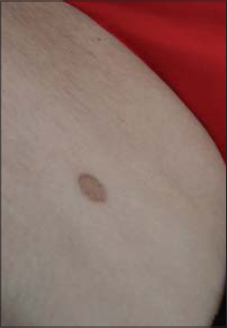Primary essential cutis verticis gyrate
Alaoui Aicha Elharrouni , Zakia Douhi, Sara Elloudi, Hanane Baybay, Fatima Zahra Mernissi
, Zakia Douhi, Sara Elloudi, Hanane Baybay, Fatima Zahra Mernissi
Department of Dermatology, University Hospital Hassan II Fez, Morocco
Corresponding author: Dr. Alaoui Aicha Elharrouni, E-mail: ealaouiaicha@gmail.com
Submission: 17.09.2019; Acceptance: 21.11.2019
DOI: 10.7241/ourd.2020e.14
Cite this article: Elharrouni AA, Douhi Z, Elloudi S, Baybay H, Mernissi FZ. Primary essential cutis verticis gyrate. Our Dermatol Online. 2020;11(e):e14.1.
Citation tools:
Copyright information
© Our Dermatology Online 2020. No commercial re-use. See rights and permissions. Published by Our Dermatology Online.
We report a case of 45 years-old patient, with no pathological history, presented for two years scalp redundancy, with deep cerebriform folds and wrinkles, located in parietaloccipital regions. She did not present neurological or ophthalmological changes. The clinical picture being compatible with CVG (Figs. 1a and 1b).
 |
Figure 1: (a and b) Cutis verticis gyrate. Cutaneous hypertrophy with cerebriform aspect of scalp, anteroposterior disposition in parietal. Regions and horizontal in occipital region. |
Cutis verticis gyrata (CVG) also known by the name paquidermia verticis gyrata, cutis verticis plicata, and “bulldog” scalp syndrome, is a rare disease, congenital or acquired, characterized by the redundancy of skin on scalp, forming thick skin folds and grooves of similar aspect to cerebral cortex gyri [1,2]. CVG can present in primary (non-essential and essential) and secondary forms [3]. The primary non-essential and secondary forms may be associated with neuro-psychiatric and ophthalmological abnormalities, while primary essential and secondary form is not associated with such abnormalities [2–3]. The treatment for primary essential CVG may be symptomatic or surgical. Orientation regarding local hygiene care is necessary to avoid secretion accumulation with unpleasant odor. Surgical treatment may be performed with the goal of improving the clinical aspect, for quality of life might be compromised due to unesthetical aspect [3].
In our case, for the exclusion of secondary causes, the tests were performed. All results were within normal limits. The patient benefitied partial resection of abundant portion of lesion with good evolution.
In conclusion, because idiopathic CVG occurs exceptionally in women, it is recommended to ruleout secondary forms. Good hygiene and surgical excision remain the adequate solution incomplicated or advanced cases with important cosmetic and psychological prejudice.
Consent
The examination of the patient was conducted according to the Declaration of Helsinki principles.
REFERENCES
1. Lamelas AM, Taub PJ, Silver L, Kressel A. Congenital primary essential cutis verticis gyrata. Eplasty. 2016;16:ic13.
2. Radwanski HN, Almeida MW, Pitanguy I. Primary essential cutis verticis gyrata–a case report. J Plast Reconstr Aesthet Surg. 2009;62:e430-3.
3. Yang JJ, Sano DT, Martins SR, Tebcherani AJ, Sanchez AP. Primary essential cutis verticis gyrata – case report. An Bras Dermatol. 2014;89:326-8.
Notes
Source of Support: Nil.
Conflict of Interest: None declared.
Request permissions
If you wish to reuse any or all of this article please use the e-mail (brzezoo77@yahoo.com) to contact with publisher.
| Related Articles | Search Authors in |
|
 http://orcid.org/000-0003-3455-3810 http://orcid.org/000-0003-3455-3810 |



Comments are closed.